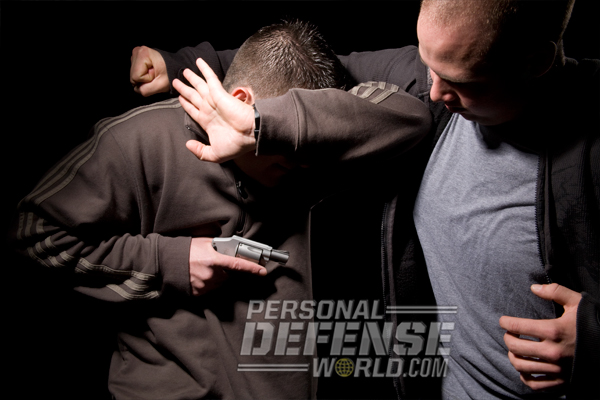Massad Ayoob examined the ongoing auto v. revolver debate with a pair of Ruger compacts for the 2014 POCKET PISTOLS. Ayoob, a self-defense expert, looked at the argument from the standpoint of concealed-carry techniques and put two compact handguns—the Ruger LCR .38 and the Ruger LCP .380—through a head-to-head test to see if either model type offered a better draw from concealment.
“Any draw of any kind requires two steps: access and presentation. Access means getting your hand onto the gun and getting it ready to draw. This encompasses clearing coats, releasing safety straps or, in this case, getting the hand into the pocket and on the gun,” says Ayoob. “This is the complicated and particularly fumble-prone part. The access stage is much more of a simple, gross motor skill: ripping the gun up and out and getting it on target and ready to fire.”
With his evaluation criteria established, Ayoob began testing his draw with the Ruger LCR. “With hands at the abdomen’s midline when the start signal came, the total time to react, get the hand in the pocket, draw the LCR and fire averaged 1.72 seconds over five runs with the revolver. The exact times were 1.74, 1.60, 1.91, 1.56 and 1.78 seconds. I have an average reaction time of around a quarter-second, and that was of course included in all timings.”
Advertisement — Continue Reading Below
Turning next to the Ruger LCP, Ayoob ran the same quick-draw drill from concealment for the auto model. “Using the same revolver protocols with the LCP pistol and starting with hands flat on abdomen, the times to access, present and fire the .380 LCP autopistol were 2.03, 1.68, 1.79, 1.65 and 1.87 seconds. This averaged 1.8 seconds, not quite 0.1 seconds slower than with the LCR revolver.”
While the quick-draw results from the tests yielded little difference between the handguns, Ayoob was able to note several distinctions from the experiment. “Firepower and shootability tend to favor the auto; simplicity and functionality in situations like muzzle-contact shooting favor the revolver,” claims Ayoob. “The square sides of an autopistol’s grip tend to ‘settle’ more flat against the thigh in trouser-pocket carry than does the rounded configuration of a revolver’s grip, causing the fingers to take a bit longer to take hold of the grip.”























